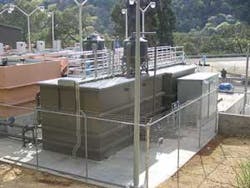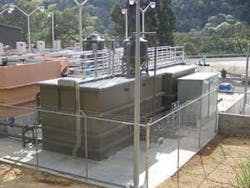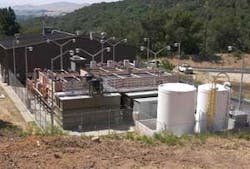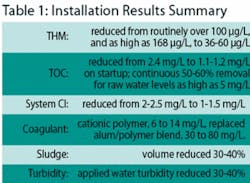The City of Vallejo's 1 mgd Green Valley Water Treatment Plant (WTP) has achieved compliance with EPA Stage 1 trihalomethane (THM) regulations through installation of a unique ion exchange treatment process that has reduced Total Organic Carbon (TOC) levels at the plant by 50-60%.
Before the magnetic ion exchange (MIEX®) treatment process began operation in early 2006, distribution THM levels exceeded Stage 1 Disinfection Byproduct (DBP) standards, routinely testing over 100 µg/L, and as high as 168 µg/L. Since then, they have been averaging 36-60 µg/L, well within the limit of 80 µg/L established by U.S. EPA's Stage 1 Disinfectants/Disinfection Byproducts Rule. The requirements of Stage 2, which must be met by 2012, have already been accomplished, with the highest locational running average THM level below 70 µg/L.
In addition to meeting current and upcoming THM regulatory requirements, significant secondary benefits have been noted, including reducing coagulant and chlorine doses by as much as 50%, and a 30-40% reduction in both sludge and applied water turbidity.
"Reducing the TOC levels so much means the new pretreatment process is removing significant amounts of negatively charged organic matter," said Franz Nestlerode, deputy water superintendent for the City of Vallejo. "The charge reduction and the nature of the matter removed dramatically affected both the type and amount of coagulant required for turbidity control. The plant now uses a highly charged cationic polymer at a dose between about 6 and 14 mg/L, while previously we used an alum/polymer blend at 30 to 80 mg/L."
"The impact on chlorine use has also been significant," he said, "with a reduction that directly parallels the TOC reduction. Before, the distribution system could never maintain a chlorine residual, even with a 3 mg/L dose, and now a residual is achieved everywhere at a dose of 1.0 to 2.0 mg/L. And with residuals now achieved everywhere, heterotrophic plate count (HPC) readings at the extremities of the distribution system are now normally not required, and negative, while before they were always required and positive."
"We have also realized a 30-40% reduction in both sludge volume and applied water turbidity." he added.
The water treatment plant's operator recalled his own experience with the new process.
"It works as I was told it would," said Milos Teply. "We got what we wanted."
"On startup in February 2006, the new system reduced TOC from 2.4 mg/L to 1.1-1.2 mg/L, with less than 0.1 mg/L removed through the downstream coagulation process," he said. "At that time, the distribution system was in violation of Stage 1 DBP regulations, and we were still seeing the 122 µg/L THM average we had before installation."
"But by the time we sampled in May 2006, the THM average was reduced to 38 µg/L and we're confident we've been consistent in that range ever since. We're running continuous, online TOC analysis that shows the same 50% removal we got initially, for raw water levels as high as 5 mg/L. If you don't have the organics, you can't generate the THMs."
"Meanwhile," he added, "the vendor has helped us to minimize operational and maintenance costs for their system. They added floats to prevent overflow of the regeneration tanks, and they replaced a low-shear pump with an air lift pump, to end the resin shear that was making us add make-up resin every three months instead of every 5-6 months."
Background
The 1 mgd Green Valley conventional package treatment plant started up in 1998 with chlorine for disinfection. Raw water was treated with a blend of coagulant, of 80% alum and 20% cationic polymer, before moving to flocculation and sedimentation basins with tube settlers. Settled water flows onto multi-media sand/anthracite gravity filters, and finally to the contact chamber and clearwell. Chlorine is added at 1.5 to 2.0 mg/L at the filter effluent, via an onsite sodium hypochlorite generator. The chlorine level typically drops to about 1.2 ppm at the contact chamber and clearwell.
In 2003, the city began evaluating options for reducing high levels of THMs at Green Valley, and to bring the system into compliance with Stage 1 DBP requirements. Reduction strategies that were investigated included changing disinfectants, reducing detention time, and removing THM-forming precursors.
"Chloramine disinfection and detention time reduction strategies were eliminated due to the expansive distribution system, and lack of capacity to provide flushing water that would have been needed to fight nitrification issues," Nestlerode said, "while chlorine dioxide was regarded as lacking sufficient effectiveness."
"Precursor removal strategies that were investigated included ozone, nanofiltration, GAC contactors, and the magnetic ion exchange process."
"Ozone was eliminated for failing to enhance TOC or precursor removal enough to achieve a THM formation potential below 80 µg/L, while nanofiltration proved too expensive. GAC and the MIEX process were then extensively pilot studied, and both achieved a sufficient TOC or precursor removal to accomplish a THM formation potential below 80 µg/L."
"GAC was very expensive in the comparison, but the ion exchange process was brand new," Nestlerode said. "The water industry likes proven technologies, but at four times the cost, it was just too expensive to stay with the tried and true GAC technology."
"I had some sleepless nights after deciding to go with a new technology, but it's turned out to be a viable method. Meanwhile, the cost of the GAC option has risen to eight times as much. All raw waters are different, and different technologies may be required to get byproducts compliance, but this one can be in the arsenal of options, and will certainly be the lowest cost for lots of agencies."
Nestlerode concluded that the new process has provided for compliance with current THM standards, added important secondary benefits, and established readiness for the coming changes in disinfection byproduct regulation.
"We've been able to reduce distribution system chlorine from 2-2.5 mg/L to 1-1.5 mg/L, because the organics that consume it are at much lower levels," he noted. "Meanwhile, we previously couldn't get a chlorine residual at the ends of the system, because the chlorine was being consumed before it reached the extremes. Now we have a residual everywhere."
"There's no more biofilm in the distribution piping, which we used to get as the chlorine level dropped further out," he added. "So now we have some haloacetic acids (HAA's) that we didn't have before, but they're low, in the 8-20 µg/L range, and our HPC's are coming in negative. It's been astounding to see how we've cleaned up the biofilm while using half the chlorine we used before.
"At the treatment plant, we've reduced by half the amount of coagulant chemicals for turbidity control, saving us $15-20,000/yr.
"We've also been able to establish readiness for the Stage 2 regulations that will be coming in 2012," he said. "The new system has us in compliance at each of four reporting locations that have been our worst detection spots, so we won't have to invest again to meet the new regulations."
The MIEX Technology was developed by Orica Watercare and two leading Australian research organizations, who worked together to develop a unique ion exchange process for the removal of dissolved organic carbon from potable water sources.
The MIEX Resin is designed specifically to be used in a continuous ion exchange treatment process that utilizes the high surface area of the resin beads to provide ion exchange in mixed or fluidized bed reactors, at very low resin concentrations and short detention times. WW
For further information on the process, visit the Orica website at www.miexresin.com.






